Text
In Defense of “Synthetic”
This is the script and slides from a talk I gave in Malmö Sweden at “The Conference” in August 2022.

When I say I’m a synthetic biologist, I usually get one of these three responses:
The first and probably my favorite is 😳what are you even talking about? This one is great, someone who’s never heard of synthetic biology! A blank slate!
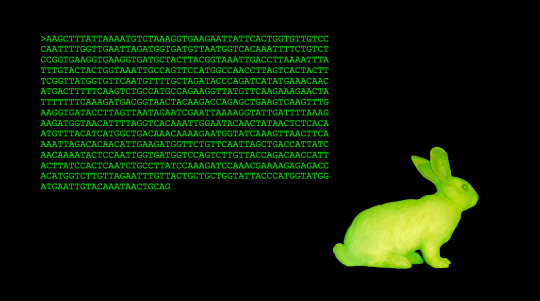
For the techy types, I can explain that it’s like programming DNA to develop new kinds of products,
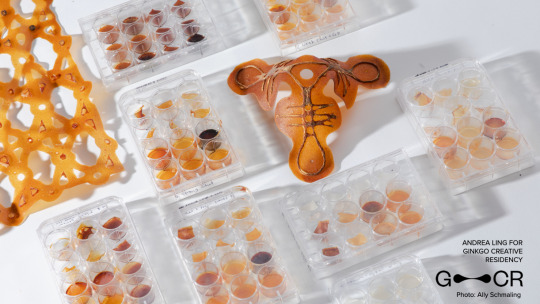
or for the more arty types maybe I can explain that it’s about designing biological materials,
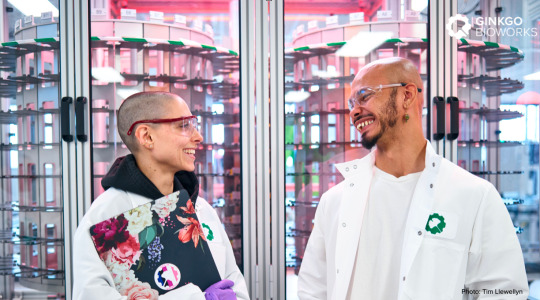
or for the more normy types with real jobs I can just say “I work in biotech.” I work for a company called Ginkgo Bioworks that does genetic engineering as a service for other businesses.
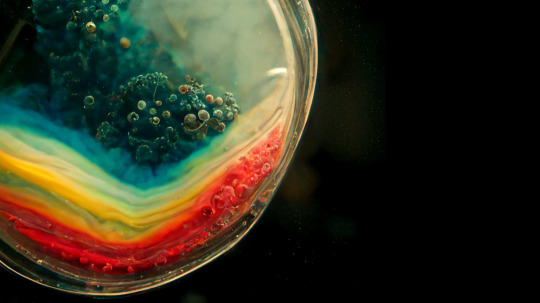
The second type of response is the jokes, and I also love these. “Oh synthetic biology, it’s like real biology but made up!” Yes, kind of! Exactly! We ARE trying to make things with biology.
Or maybe something more like “huh, a synthetic biologist—like you’re a robot doing experiments?” Um also sort of? In my lab days I sometimes felt like a robot
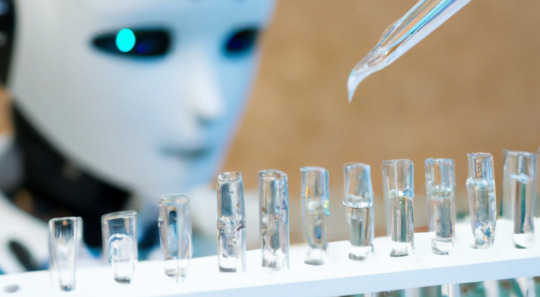
and these days at Ginkgo we use tons of robots to make biology easier to engineer.

There’s a third one that looks at synthetic biology as a brand, which is something I think about a lot in my role, where I work on design, communication, ethics, policy, perception–in one word, our brand.
Brand comments actually takes two forms: On one side you have the people who think that synthetic biology is only a “good brand”—is synthetic biology anything at all other than a rebranding of genetic engineering that’s better at raising capital from VCs, or perhaps tricking people into not thinking about GMOs? On the other side you have the people who think synthetic biology is a terrible brand “don’t you know people hate things that are ‘synthetic’? You really should rebrand.”

So I’ll start with the latter—the people who think I should rebrand since synthetic is bad—because I get it, synthetic has come to mean anything made with old biology, from the fossil fuels that humans have managed to extract from the ground and refine into the myriad things that we enjoy in our everyday life. Synthetic means unnatural, it means pollution, chemicals–it comes from this world, not the world of living things. No one wants synthetic, everyone and everything wants to be natural (no matter how they are actually made).

So I’d like to offer a defense of synthetic, not because I love smoke stacks and fossil fuels and not because it’s a “good brand” for GMOs, but for ideological reasons—because at its heart synthetic is about bringing things together to make something greater than the sum of its parts.
Synthetic does not need to mean the opposite of natural, and in fact the reason why we think it does is exactly why I think we need to embrace synthesis again. The concept of nature is built on a fundamental division.

It is about cleaving ourselves as humans from everything else. We define nature as that which is not us, nature is everything outside of the human world. Nature is the opposite of culture, it’s the opposite of technology.
In this formulation, nature is separate from and it is below us, something that we must dominate and control so that we may survive and flourish. Synthetic materials made by humans therefore offered us better living through chemistry because technology was meant to save us from the vicissitudes of the growing cycles and the whims of weather and pestilence.

Today, many of us in industrialized parts of the world have become free from the tyranny of nature, but we suffer from new tyrannies of pollution and climate change. We therefore seek out ways to go back to natural, but even now “natural” still depends on the same fundamental principle of separation and control, which then permeates the marketing and culture of natural products. “Natural” now is about the quest we must go on to choose the right products to purify ourselves from the sins of synthetic chemistry. Natural in this case isn’t really about connecting with that which is outside of us, but again becomes about a kind of exclusion, this time what our products are ”free from.” These new purity rituals define so much of our relationship to our everyday life and culture, from the foods we eat to the cosmetics and even medicines we choose.
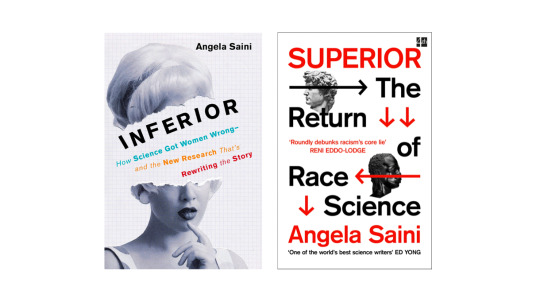
Much more sinister and damaging is how nature and science have been used as tools of social control, to justify the divisions and dominations of colonialism, white supremacy, and patriarchy. From ideas about women’s “natural” roles in society, to the “natural” or biological obviousness of the gender binary and heterosexual monogamy, to “natural” differences between populations from different parts of the world, this kind of appeal to “scientific facts” about the “natural” order of things has always been used as a tool of oppression.
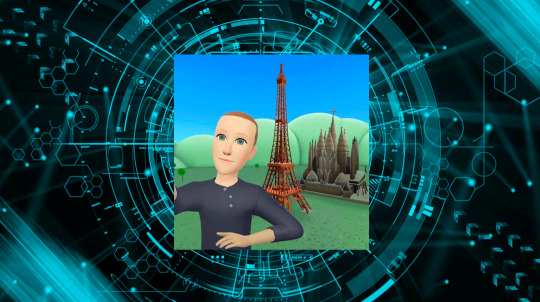
The division between nature and technology also means that we have inherited a very atrophied imagination of what technology can be, and a technology that continues to replicate these social structures of domination. “Technology” becomes a very specific type of work, associated with a very particular type of person. It affects what we value, what we invest in, what we pay attention to. Ursula Le Guin lamented this in a rant on technology and about how her own work was devalued as less “scientific” than other kinds of sci-fi because it deals with technology in a much more expansive sense, as, in her words, “the active human interface with the material world.”
Instead of this expansive technology, we have a much more limited view of technology and technological visions that seek to entirely escape the physical reality of this world while still enforcing scarcity in order to perpetuate systems of control.
I think it’s time for a very different vision. Not to rebrand synthetic biology, but to reconfigure the relationship between nature and technology and the synthesis of the two. We don’t want the divisive technology of the metaverse, but the synthetic technology of the meatverse.
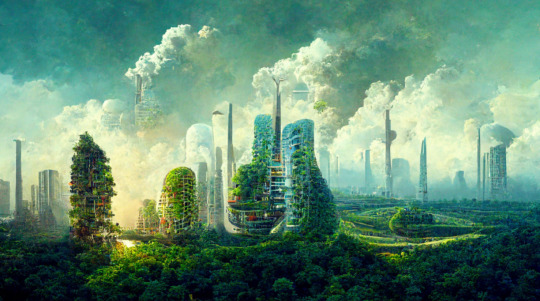
We need to celebrate the meatverse because our technology is also pathetically small when compared to what biology can do. What is a computer compared to four billion years of evolution? Of organisms that can grow anywhere, of seeds that can grow into plants, a pulling carbon dioxide out of the atmosphere. Humans can’t figure out how to make things without asphyxiating our planet and filling it with garbage. Biology makes all of us, all our bodies, all of this in a fundamentally regenerative way. We have to learn to work with biology, and bring these worlds together synthetically.
This is an urgent task. We have reached the end of what is possible to sustain with technology cleaved off from nature. Our attempts to dominate nature in order to free ourselves from the scarcity of our environments have led to a world where we have more than we need but we face a threat of extinction because of our technology’s exhaust. Murray Bookchin, a theorist and pioneer of the environmental movement wrote in his book Post-Scarcity Anarchism that “Man had to acquire the conditions of survival in order to live, now we have to acquire the conditions of life in order to survive.”
I believe that for us to survive and flourish, the future must be synthetic: a union of nature and technology, and of science and technology with politics, art, and culture. These synthetic movements must remove not only our desire to dominate nature but also to dominate each other.
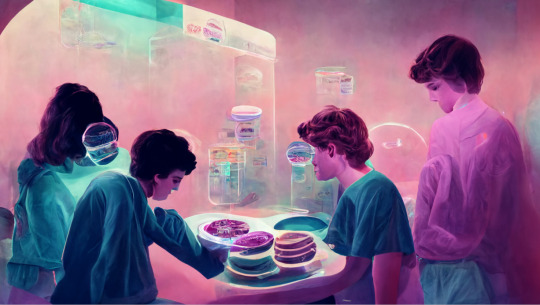
So I’ll leave you with a sketch of what this synthesis could look like. A world where we can revel in our biological experience and our creative energy can grow and shape the physical world. Where we can design new materials and new experiences together with nature. Where students and scientists can exchange new biological programs the way they share make-up tips on tiktok.

Where your local pharmacy brews new strains of microbes producing the ingredients and medicines you need, grown to order in custom strains. Your local flower shop sells seeds with custom genomes, accounting for our allergies and preferences.
Where your living room is appointed with the coziest mushroom material, and our fashion is shaped by the dynamics of cell cultures and the custom colors and patterns we co-design with them.

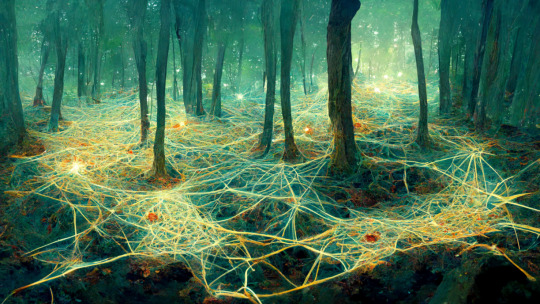
Where, biological programmers log into the wood wide web using the latest web-tree protocols. Our conversations are written in DNA. Where industrial pollution once left behind damaged soil, we grow new forests.
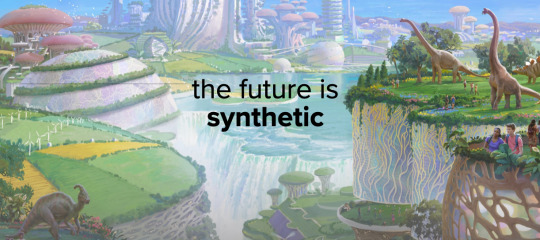
I believe that the future is synthetic—because the future depends on what we can imagine and make together.
I hope you’ll join me.
4 notes
·
View notes
Text
In the meatverse

In the meatverse, creative energy shapes our physical world. We design, together with nature, biological processes to grow what our fleshy bodies need. The materials that make our buildings and soften our spaces; the fabrics and dyes that delight our senses; the foods that fill our stomachs and fuel our cells.
In the meatverse, biological programmers log into the wood wide web using the latest web-tree protocols. Our conversations are written in DNA. Where industrial pollution once left behind damaged soil, we grow new forests.
In the meatverse, there’s a new kind of tiktok house. Kids whose grandparents played with the first home cloning kits live together, dazzling each other with newer and stranger organisms. We shop on Etsy for the plasmids that genetically engineer our shared gardens. With custom genomes, the fruits and vegetables account for our allergies and tastes. Our house plants glow. Maybe our pets do too.
The children of the meatverse grow furniture and clothes alongside our food experiments, allowing them to gently decay when it’s time for a new look. When it’s our turn to make dinner, we program a cell printer to stack animal cells (grown in the neighborhood bioreactor) into different shapes and forms. The latest gimmick in celebrity meats gets eye rolls from around the table, but the flavor is unimaginable. Different programs for that same neighborhood bioreactor produce common medicines from antibiotics to insulin — everything we need.
In the meatverse, life is good.
2 notes
·
View notes
Text
Standing up for science
In the two weeks since the election, I’ve seen a lot of talk about “standing up” for science. Science Magazine put an ad for new AAAS memberships under a photograph of the white house, with a call to “stand strong” and “speak up for science” emphasizing funding and research investment, science communication, and climate change.
In the same two weeks, I also saw:
a pre-print of a computer science article about using machine learning to identify “criminality” in photographs of faces
an article about the science of “educational genomics,” where students can be tracked into different classes according to their genetic potential
and an article speculating that China would be the first to use CRISPR to create “superhumans”
When the EPA transition is being led by someone who said “I am not a great believer in man-made climate change,” it is vital that we all stand up for the future of our world. But when overt racism is now daily coming from the most powerful people in the country and hate crimes are rampant, we must also stand up and recognize when science further reinforces oppression and speak up for marginalized people.
The examples above show how "objective" scientific treatment of social phenomena can backfire and enable racist policies. An algorithm to detect "criminality" from facial features is going to be biased the same way our criminal justice system is biased along racial and socioeconomic lines. A program to match students to courswork based on genetics will be biased the same way our educational system is along racial and socioeconomic lines. Speculation about "superhumans" traffics in racist stereotypes about Chinese ethics and the problematic belief that ability is defined more by our genes than by our environments.
Scientists aren't immune to the blind spots and biases of our culture and science has long been an instrument of normalizing and naturalizing prejudice. Today, those scientists are more likely to complain about "political correctness" than appeal to our sense of "natural" hierarchies. At the same time, white supremacists tout James Watson's Nobel Prize alongside his abhorrent beliefs about intelligence and race (let's save discussion of the "anti-science" label for another time).
To stand up for science in our uncertain political time, we have to think beyond budgets—I'm going to stand up for a better science. I'm going to stand up for scientists who are being harrassed, whose identities leave them vulnerable, and stand with all who are standing up for a science that includes diverse voices. I'm going to stand for science that works for all of us.
7 notes
·
View notes
Photo

"Science and engineering today, however, is focused on things like synthetic biology or artificial intelligence, where the problems are massively complex. These problems exceed our ability to stay within the domain of the artificial, and make it nearly impossible for us to divide them into existing disciplines. We are finding that we are more and more able to design and deploy directly into the domain of “nature” and in many ways “design” nature. Synthetic biology is obviously completely embedded in nature and is about our ability to “edit nature.” However, even artificial intelligence, which is in the digital versus natural realm, is developing its relationship to the study of the brain beyond merely a metaphorical one. We find that we must increasingly depend on nature to guide us through the complexity and the unknowability (with our current tools) that is our modern scientific world."
Joi Ito on Design and Science: http://www.pubpub.org/pub/designandscience
131 notes
·
View notes
Text
Predicting the fungi-based economy
I love this passage from Isaac Asimov's I, Robot predicting the fungal economy:
In the first place, by far the largest crop we deal with (and the percentage is growing) is yeast. We have upward of two thousand strains of yeast in production and new strains are added monthly. The basic food-chemicals of the various yeasts are nitrates and phosphates among the inorganics together with proper amounts of the trace metals needed, down to the fractional parts per million of boron and molybdenum which are required. The organic matter is mostly sugar mixtures derived from the hydrolysis of cellulose, but, in addition, there are various food factors which must be added. "For a successful hydroponics industry - one which can feed seventeen hundred million people - we must engage in an immense reforestation program throughout the East; we must have huge wood-conversion plants to deal with our southern jungles; we must have power, and steel, and chemical synthetics above all." "Why the last, sir?" "Because, Mr. Byerley, these strains of yeast have each their peculiar properties. We have developed, as I said, two thousand strains. The beef steak you thought you ate today was yeast. The frozen fruit confection you had for dessert was iced yeast. We have filtered yeast juice with the taste, appearance, and all the food value of milk. "It is flavor, more than anything else, you see, that makes yeast feeding popular and for the sake of flavor we have developed artificial, domesticated strains that can no longer support themselves on a basic diet of salts and sugar. One needs biotin; another needs pteroylglutamic acid; still others need seventeen different amino acids supplied them as well as all the Vitamins B, but one (and yet it is popular and we cannot, with economic sense, abandon it)-"
More on yeast making stuff in 2015 from WIRED: *Science fiction that came to life this year *The year in biology and medicine *Are microbes the taste makers of the future? *Don't try this at home: scientists brew opiates with yeast
2 notes
·
View notes
Photo

My latest post for Re:form is up today, about the Biofabricate symposium last month and the role of designers in developing new ways of working with biology.
Natsai Chieza dyes silk with living bacteria. A UK-based textile designer working in John Ward’s microbial molecular biology lab at University College London, Chieza works with the common soil bacteria Streptomyces, which can produce a range of pigments. She grows these microbes in 150 millimeter petri dishes, carefully folding large pieces of fabric into the circular dishes. The dyes transfer to the silks as the bacteria grow and excrete the pigmented molecules. After heat-treatment to pasteurize the fabric, the color-fast bacterial dye leaves beautiful rorschach patterns on the silk.
Speaking at the Biofabricate symposium organized by Suzanne Lee of Biocouture, researchers at Microsoft, and the synthetic biology community group SynBioBeta, Chieza’s stories of working with microbes offered a striking contrast to many of the talks by synthetic biologists and engineers. Where synthetic biologists spoke of automation, “deskilling,” and removing the possibility of both human error and biological unpredictability from their designs, Chieza emphasized the importance of serendipity, craft, and process. She found pigmented bacteria living in the soil of her garden, and identified a new color when mold accidentally “contaminated” her petri dishes. Though she works alongside research scientists, she forges her own experimental path to these findings; she recounted learning a particular lab technique that was taking her several weeks to master. Graduate students working at the bench nearby told her she could change her technique and be done in just a few hours. But she didn’t want to just finish quickly, she wanted to “learn what it really means to work with biology.”
For Chieza, learning to work with biology meant adapting old lab techniques and creating her own methods to find, domesticate, and nurture the pigment-producing bacteria. Unlike many other contemporary designers and engineers working with biological materials, Chieza is not interested in the techniques for manipulating the bacteria’s DNA directly. In an interview with Wired, Chieza comments that using genetically engineering organisms to produce pigments is “fine, but that would be quite boring for me.”
Bacteria already produce and secrete an enormous range of pigmented molecules; the challenge is in finding them and developing the techniques of growing them and transferring their pigments to fabric.
Chieza has identified species that produce a range of colors, and she can coax the bacteria to change hue and intensity depending on the pH of the medium, the sugars she feeds them, the temperature of the incubator she grows them in, and which strains are grown together. She guides and shapes the growth of living cells, altering their behavior and the expression of their genes without touching their DNA.
Biofabrication 101 | Medium | Re:form
2 notes
·
View notes
Link
Excellent article by Ben Lillie on the misleading framing and poor methodology of the widely-quoted finding that 80% of Americans support mandatory labeling of food that "contains DNA."
To be clear, I’m not saying 100% of people perfectly understand DNA, not by a long shot. There are certainly a significant number of people who don’t understand that there is DNA in food. But it’s almost certainly not 80%. (This survey suggests 15% is a better guess.) I’m also happy to see that there were other people questioning the result. (Links there to two I happened to see, I’m sure there were more.)
I also think most of the people tweeting the 80% number are excellent scientists and science writers. But as Dan Kahan is fond of pointing out, we can’t go back and analyze every number. We mostly have to rely on heuristics for evaluating whether we believe facts we’re presented with. We only go and poke at numbers if they seem wrong. What that means is that “80% of people don’t know there’s DNA in food” didn’t register as odd for quite a lot of people. I think that’s a problem. “The US public is incredibly stupid about science” is a hell of a seductive narrative for scientists. And for that reason it’s very much worth questioning.
75 notes
·
View notes
Text
On Democratization
In the early 1970’s, several Dutch universities created “science shops” (wetenschapswinkels) with the aim of democratizing science. The science shops connected public interest groups who had scientific questions with university students and researchers who could provide answers. Opening access to university research would help activist groups achieve their goals, and would also have an impact on the universities themselves. In an essay for the journal Science, Technology & Human Values, Joseph Wachelder writes about the more radical goals of the science shops early on:
The democratization of science in fact implied a general and even radical transformation of society. The aim was to reorient science toward the social needs of workers and disadvantaged groups and to fight the vested interest of the establishment and the so-called military-industrial complex. In those early days, the political Left pushed science shops as one means of transforming both science and society in radical ways. Unions, targeting issues such as occupational health, social security, and working conditions; environmentalists; patients’ groups; third-world activists; and, slightly later, women’s liberation groups considered themselves as partners in pursuit of a new and better society.
I read about the science shops for the first time over the holidays in Making Genes, Making Waves, Jon Beckwith’s autobiography about his research in molecular biology and his political activism. Given the current fad for “democratizing science” I was surprised that I’d never heard them mentioned before.
Indeed, today’s democratization looks a lot different from the democratization pushed by science shops and radical science movements of the 70s. Science for the People, an activist group of scientists and engineers founded in the early 1970s, organized against the misuse of science by military and corporate interests and advocated that science work for marginalized people rather than maintaining the status quo. A powerful symbol for the group was a fist raised in solidarity next to a hand holding a flask. Alice Bell notes in a recent article on activist science that, “The fist of solidarity stood in front of the chemist's flask here, not simply used to hold science up high.”

Compare that with Science for the People, a Canadian radio program about science, which rebranded in 2013 from “Skeptically Speaking.” Their logo echoes the Science for the People cover image from 1970, but here the fist holds up a test tube—literally holding science up high. In a blog post about their rebrand, the producers discuss what “science for the people” means to them:
We're about getting the word of something we love to people who might not hear about it anywhere else, in the hopes that maybe, just maybe, they'll love it a little too. We're about taking tough scientific concepts and teasing out what matters. We're about taking the latest in scientific progress and relate it to people like our friends and our families, and our communities, and our society.

Telling people about your love for science is great, but as Bell notes (referring to the flask-toting fist on the cover of the Geek Manifesto), “Looking back at these earlier radicals, [it] seems to pale to a Che Guevara T-shirt in comparison.”
Other efforts seem similarly pale when you begin to examine their claims about democratization in light of what democratization meant to more political generations of scientists. Like the Science for the People radio program, many of these efforts are focused on the one-way transmission of science from the academy to the public, rather than a radical transformation of science itself to address public interests.
Open access publishing has made it easier to publish and read scientific articles, and is gradually (hopefully) chipping away at the tyranny of the impact factor in academic career advancement. These are worthy goals which I support whole-heartedly—I've published most of my papers in open access journals—but making papers open to download doesn't necessarily make science democratic and open to everyone.
Likewise, recent efforts to get more people involved in scientific research have been branded "citizen science," but unlike the science shops where the citizens dictated research directions, citizen science projects simply allow non-scientists to volunteer their time collecting or analyzing data for professional researchers. These projects can be great learning experiences, allowing non-scientists to get a better picture of the scientific process, as well as great research experiences, allowing scientists to explore topics that they couldn't have done without the expanded team. But letting people do free work for you isn't the same as doing work for people.
In synthetic biology, "democratization" has recently been used as a marketing ploy for companies that are selling DNA or DNA editing software. Cambrian Genomics and Genome Compiler both claim to "democratize creation," an empty statement that helps drive press coverage and TED invitations in the crowded genetic engineering market. Both companies are selling slightly different, cheaper, or easier to use versions of things that have been sold to molecular biologists for decades, but claiming that their versions will suddenly make it possible for "anyone" to do genetic engineering. Making cheaper and more accessible laboratory tools is great, but it's worth asking what else is necessary to truly make "creation" accessible (I'm not going to get into the differences between synthesizing DNA and "creating life" here, but suffice it to say that I don't agree with that part of their phrasing either). There are many other tools, training, and above all a reason to do it that are all necessary in order to make a "creature." It's no surprise then that, according to SF Gate, Cambrian currently sells DNA primarily to biotech giants like Roche, GlaxoSmithKline, and Thermo Fisher. If you don't work to really democratize science, you're just making cheaper tools for the people who already had access to them. (Also hype, lots of hype.)

The contemporary projects that seems most like the 70s Dutch science shops are today's hackerspaces and community labs, where non-expert scientists can explore techno-scientific questions on their own time (and usually on their own dime). While there are a huge variety of projects and educational goals in these spaces, a particular kind of "hacker" has gone mainstream (and even received DARPA funding). Tinkering in a garage is now seen as the first step towards starting the next multibillion dollar Silicon Valley company. Hackerspaces can be the site of anti-establishment thinking, but they are also becoming part of the military-industrial complex.
None of these projects are necessarily bad. By and large, they all point towards a broader positive shift happening in the scientific community towards more transparency, accountability, diversity, and public involvement. But we shouldn't let something as important as democratization become an empty label. We need to be critical of self-proclaimed democratizers—who is benefitting and who remains left out? Who is calling the shots and who is working for whom? Where does the money come from? How can we do science better?
7 notes
·
View notes
Video
youtube
Paola Antonelli speaking about Synthetic Aesthetics at the recent MoMA event Designing Life: Synthetic Biology and Design.
0 notes
Quote
"We have come to look at feminist critique as we would any other experimental control. Whenever one performs as experiment, one sets up all the controls one can think of in order to make as certain as possible that the result obtained does not come from any other source. One asks oneself what assumptions one is making. Have I assumed the temperature to be constant? Have I assumed that the pH doesn't change over the time of the reaction? Feminist critique asks if there may be some assumptions that we haven’t checked concerning gender bias. In this way feminist critique should be part of normative science. Like any control, it seeks to provide critical rigor, and to ignore this critique is to ignore a possible source of error."
The Importance of Feminist Critique for Contemporary Cell Biology
1 note
·
View note
Text
Hello Again
It’s been almost five years since I updated this version of Oscillator. In that time a lot has happened in my life, in synthetic biology, and in science blogging. I moved my blog to Science Blogs and then to Scientific American. I published academic articles about bioenergy, symbiosis, olfaction, and design. I finished my PhD and a couple postdocs. I taught engineers and artists about biology. I wrote about a lot of things besides synthetic biology, and I started a new magazine.
Returning to this blog is both refreshing and embarrassing. Reading my old posts — or worse, my old drafts — reminds me of what excited me about synthetic biology and shows me how much I’ve learned since then. I haven’t been able to write nearly as often as I did five years ago, but my plan is to sporadically update this blog with links and short posts about the things that are exciting me now.
1 note
·
View note
Text
Oscillator is Moving!

I'm super excited to be moving Oscillator over to ScienceBlogs! Make sure to update your bookmarks and visit me over at http://scienceblogs.com/oscillator!
4 notes
·
View notes
Text
"Synthetic" Biology and Evolution by Symbiosis
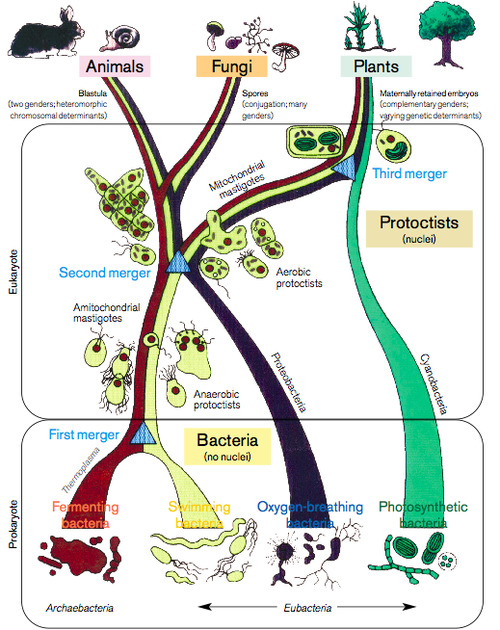
I like using synthetic to mean "working together", in "real" synthetic biology as bringing together (synthesizing) a lot of components from different living things in order to create a unique whole, and in "natural" biology in terms of how every living thing must live together with others in communities made up of complex interdependent relationships. I've recently been reading a lot of Lynn Margulis's work on Serial Endosymbiotic Theory (SET): how eukaryotic cells developed through multiple endosymbiotic events between different species of bacteria, with early cooperative relationships leading to intricate co-dependence and entire new domains of life. I love this picture from her article "Serial endosymbiotic theory and composite individuality" for its complexity and for highlighting how deeply connected all life on earth is. We are all synthetic communities.
4 notes
·
View notes
Text
Synthetic Sources of Natural Rubber
Rubber can be made chemically from fossil fuels, but natural rubber from tropical trees is still the best source, and in many cases the only usable one (car tires need a lot of natural rubber for the right combination of strength and elasticity). Besides being difficult to grow and relatively inefficient, rubber trees are also facing a fungal plague that could potentially wipe out natural rubber within the next few years. Many labs (including mine) are trying to find or engineer different sources of biological polymers. According to a neat article in The Economist, two groups are working with dandelions as potential a new source of natural rubber. One group is using RNA interference to knock down the expression of a gene that makes the rubber polymers that the plant already makes difficult to process, and the other is using more traditional breeding technologies to improve rubber production, selecting and crossing high producers. Not only do dandelions already produce significant amounts already, but their fast growth and ability to grow just about anywhere (which makes them such good weeds) may make them a valuable agricultural commodity.
It’s an interesting project in many ways. Biological polymers are a fascinating and very broad subject, and understanding and engineering how enzymes make and break down these polymers will undoubtably be important for industrial biological engineering. Moreover, a sustainable biological method for producing rubber locally (instead of the current synthetic methods) will be important for environmental conservation and decreasing oil dependence.

However, this also means that there will be serious competition for rubber tree farmers, with likely many negative effects for the economies of Malaysia, Thailand, and Indonesia, the world’s top rubber producers. This has already happened, when the first round of synthetic—but not as good—rubber entered the market, as well as when indigo dyes began to be chemically synthesized, irreparably damaging the Indian dye economy. These and other issues are discussed in an interesting article by Political Scientists working at MIT, “Aspects of the political economy of development and synthetic biology” from a special issue of Systems and Synthetic Biology. These are important but often neglected aspects of the discussion of the risks and benefits of the potential applications of synthetic biology.
4 notes
·
View notes
Text
Jonah Lehrer on Failure
A great article about failure and science by Jonah Lehrer in Wired, Accept Defeat: The Neuroscience of Screwing Up. I will quote the part about the work of Kevin Dunbar studying how scientists work in their "natural environment" at length because it is awesome:
Science is a deeply frustrating pursuit. Although the researchers were mostly using established techniques, more than 50 percent of their data was unexpected. (In some labs, the figure exceeded 75 percent.) “The scientists had these elaborate theories about what was supposed to happen,” Dunbar says. “But the results kept contradicting their theories. It wasn’t uncommon for someone to spend a month on a project and then just discard all their data because the data didn’t make sense.” Perhaps they hoped to see a specific protein but it wasn’t there. Or maybe their DNA sample showed the presence of an aberrant gene. The details always changed, but the story remained the same: The scientists were looking for X, but they found Y...
The experiment would then be carefully repeated. Sometimes, the weird blip would disappear, in which case the problem was solved. But the weirdness usually remained, an anomaly that wouldn’t go away.
This is when things get interesting. According to Dunbar, even after scientists had generated their “error” multiple times — it was a consistent inconsistency — they might fail to follow it up. “Given the amount of unexpected data in science, it’s just not feasible to pursue everything,” Dunbar says. “People have to pick and choose what’s interesting and what’s not, but they often choose badly.” And so the result was tossed aside, filed in a quickly forgotten notebook. The scientists had discovered a new fact, but they called it a failure.
The reason we’re so resistant to anomalous information — the real reason researchers automatically assume that every unexpected result is a stupid mistake — is rooted in the way the human brain works. Over the past few decades, psychologists have dismantled the myth of objectivity. The fact is, we carefully edit our reality, searching for evidence that confirms what we already believe. Although we pretend we’re empiricists — our views dictated by nothing but the facts — we’re actually blinkered, especially when it comes to information that contradicts our theories. The problem with science, then, isn’t that most experiments fail — it’s that most failures are ignored.
6 notes
·
View notes
Text
2009 Year in Review

2009 was a big year for synthetic biology in the academic press. Several journals had special issues devoted entirely to the topic, most recently Nature Biotechnology, but also Molecular BioSystems, The Journal of the Royal Society Interface, Systems and Synthetic Biology, and EMBO Reports with excellent research articles, reviews, and fascinating commentaries on economic, ethical, and social issues in synthetic biology. Beyond that Google Scholar returns over 1,000 results for "synthetic biology" in 2009, most of which I unfortunately have not had the chance to read. Of the few hundred where I at least read the abstract I have collected my favorites, the TOP 12 PAPERS IN (broadly defined) SYNTHETIC BIOLOGY OF 2009 (according to one grad student)!!! They're numbered for convenience more than anything, I couldn't possibly rank them more specifically, deciding on this few was hard enough. If you have favorites that I missed, please add them in the comments!
-----------------------------------------------------------------------------

1.) A tunable synthetic mammalian oscillator, Tigges et. al. Nature, 457, 309-312.
You maybe could tell that I am partial to oscillators, the darling of synthetic biology circuits. Oscillators are cool because they are hard to make, have a clear analog in electrical engineering, are important in many natural biological systems (for a really cool article about circadian rhythms and you, check out Olivia Judson's New York Times blog post), and could be used as a component for future synthetic systems where timing is important. This paper from Martin Fussenegger's group is the first robust, tunable synthetic oscillator in mammalian cells; that is, individual cells will glow on and off for many cycles with a time period that can be changed by the experimenter. It's a big step in terms of oscillator design, and future work will further improve the oscillations and allow for synchronized behavior between populations of cells.
2.) A synthetic mammalian electro-genetic transcription circuit, Weber et. al. Nucleic Acids Research, 37(4) e33.

Another paper from the Fussenegger group, this one is interesting because it brings a new input system to mammalian cell engineering: electricity. It's not a direct electrical input, as with voltage gated channels (which I think would be cooler, but also requires using specific cell types), but uses the indirect electrochemical breakdown of ethanol to acetaldehyde to activate a synthetic gene network through a promoter that responds to acetaldehyde.
3.) Programming cells by multiplex genome engineering and accelerated evolution, Wang et. al. Nature, 460, 894-898.

Optimization of synthetic (or natural) metabolic pathways for the highest possible production of a desired product can be tedious and extremely time-comsuming work. Researchers from the Church lab at Harvard created a robot that would automatically perform cycles of mutating E. coli genomes and then selecting for cells that produce more lycopene (an important industrial chemical). In a matter of hours they were able to test billions of variations and come up with an optimized pathway that makes more lycopene than the natural system and synthetic pathways that have been more laboriously engineered. This Multiplex Automated Genome Engineering (MAGE) method has the potential to make the dream of fast, easy biological engineering a reality by automating directed evolution on a genome scale.
4.) Synthesis of methyl halides from biomass using engineered microbes, Bayer et. al. JACS, 131(18), 6508-6515.

Synthetic biology blurs the lines between species, treating natural ecosystems as bags of genes to be mined and annotated, searched and modeled, synthesized and networked. It's hard to tell from the sequence alone though how good an enzyme from a certain species will work in your chassis, how it will cooperate with the other components in your pathway, whether it will even function at all. This paper from the Voigt lab deals with just that problem with brute force testing of ninety variants of a single enzyme, collated from genomic datasets and synthesized chemically for expression in E. coli. It's incredible for the scope and scale, for the output--very high levels of methyl halides, precursors of many important chemicals including fuels--and for the work towards improving our understanding of enzyme function vs. sequence (and the idea that it's going to take a lot more than bioinformatics alone to get the job done).
5.) Synthetic protein scaffolds provide modular control over metabolic flux, Dueber et. al., Nature Biotechnology, 27, 753-759.

Chemical engineers think of industrial production of chemicals in terms of pipes and vats, and genetic engineers use the language of chemical engineering in analogy: cells as "vats", pathways as "pipelines," with chemical intermediates passed between different enzymes that perform different chemical processes in the transition from input metabolites to useful chemicals. This paper from the Keasling lab uses a synthetic scaffold protein to capture and link together the enzymes of a particular pathway to make a more literal pipeline, drastically improving the function of the pathway be preventing "leaks" of the intermediate chemicals that are harmful to the cell. The scaffold protein itself is interesting because it is made up of proteins that control signal transduction in human cells, creating an entirely parallel system in bacteria that will not interfere with signaling or metabolism of the chassis cell. Not only that, it's been useful for my research (maybe one of the big papers of 2010!)
6.) A synthetic genetic edge detection program, Tabor et. al. Cell, 137(7), 1272-1281.

The "bacterial camera" made with a synthetic light-sensing pathway has been around since 2005, with bacteria that turn black in response to red light, essentially "printing" an image onto a petri dish covered in the cells. This paper improves on the old design with the addition of many new abstractable transcriptional logic components. Instead of every cell that experiences the light turning color, the bacteria only activate color production when they experience something different from their neighbors, so that only the edges of the lit-up area turn dark. It's a neat little system, and represents a very sophisticated and compex synthetic network made up of many components.
7.) Spatiotemporal control of cell signalling using a light-switchable protein interaction, Levskaya et. al. Nature, 461, 997-1001.

Light can also be used to activate synthetic pathways in mammalian cells (!!!). This paper is great, it introduces a totally new way of interacting with mammalian cells and it introduces a new functional "part" for synthetic biology, controlling the cytoskeleton to directly alter the shape of the cell. Awesome!
8.) Systems-level engineering of nonfermentative metabolism in yeast, Kennedy et. al. Genetics, 183(1), 385-97
This one is a little biased (it's from my lab), but it's a neat paper that uses metabolic modeling in order to find non-intuitive gene deletions that would increase metabolic flux through the formate production pathways in yeast (formate is an industrial commodity and is can be efficiently converted to hydrogen gas by E. coli). The modeling is called flux balance analysis, which uses only steady state information about metabolism in order to find optimum "solutions" to how the cell allocates resources. It's an interesting way to solve the problem of first of all collecting all the data and second of all having enough computational power to actually model metabolism as the dynamic system that it is, and it can be used for rapidly generating interesting hypotheses and designs for metabolic engineering.
9.) Snowdrift game dynamics and facultative cheating in yeast, Gore et. al. Nature, 459, 253-256.

This is one of my new favorite things--evolutionary dynamics of symbiosis using synthetic "ecosystems" of several species of microorganisms that "cooperate" or "cheat" by using the environment's resources without giving other cells anything in return. It's a fascinating look at how cooperation may be more "natural" than we think, and that evolution and natural selection don't have to be just about bloody and selfish competition for survival. Expect a lot more about this from me in 2010!
10.) Measuring the activity of BioBrick promoters using an in vivo reference standard, Kelly et. al. Journal of Biological Engineering, 3(1).
It's hard to believe that this paper only came out in 2009, because this kind of foundational work on characterizing BioBrick parts is so critically important for the engineering of biological systems. Almost every project in synthetic biology involves an extended period of optimization, and kinetic components such as promoter strengths are a main focus of such efforts. With a standardized, reproducible method for comparing different promoters, it will be much easier to choose parts "off the shelf" for future synthetic biology project. There is a lot more work to be done, and it will need a lot more papers (or specification sheets?) like this.
11.) Solving a Hamiltonian Path Problem with a bacterial computer, Baumgardner et. al., Journal of Biological Engineering, 3(11).
This paper comes from the 2007 Davidson-Missouri Western iGEM project, where the students used engineered genetic systems in bacteria to solve an NP complete problem. Cool!
12.) How to choose a good scientific problem, Uri Alon, Molecular Cell, 35(6), 726-728.
To round out the list, the least synthetic biology paper, but a thought-provoking, important, and wonderfully touchy-feely look at nurturing good scientists as a mentor and good advice for students for choosing interesting and important problems to study and how to go with the flow when things inevitably don't work as planned.
-----------------------------------------------------------------------------
That was 2009, here's to a happy, healthy, intellectually stimulating 2010!
4 notes
·
View notes